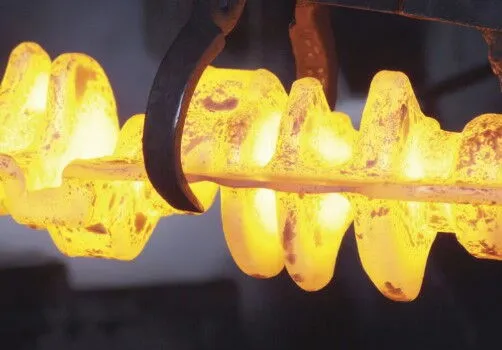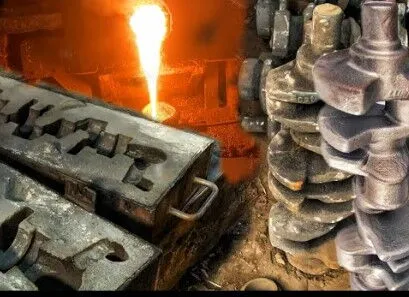The crankshaft is one of the most important components in an engine. Its primary function is to convert the force transmitted by the connecting rods into torque, which drives other accessories within the engine. During engine operation, the crankshaft faces forces from centrifugal forces, periodic gas inertial forces, and reciprocating inertial forces. Therefore, the crankshaft must have sufficient strength, stiffness, and excellent wear resistance. Additionally, the crankshaft's journal surfaces need to be smooth, uniform, and well-balanced to ensure long-term, efficient, and stable operation.
Selecting the right materials and manufacturing processes is crucial when making a crankshaft. There are two main manufacturing methods: forging and casting. Each method has its unique characteristics and is suited to different applications and requirements. This article provides a detailed analysis of the forging and casting processes for crankshafts. It helps to understand the advantages, disadvantages, and applications of each method.
Forging is a process in which metal is heated to a specific temperature and then shaped into the desired form through mechanical force or pressure. Crankshafts are usually forged using high-precision equipment, such as hot-die forging presses or hydraulic hammers. Compared to casting, forged crankshafts have significant advantages in strength, fatigue resistance, and precision.

High Strength and Fatigue Resistance: During the forging process, metal undergoes plastic deformation, forming a continuous metal flow structure. This structure increases the tensile strength and fatigue resistance of the crankshaft. Forged crankshafts are better at withstanding high loads and vibrations during engine operation. This significantly extends their service life.
Improved Internal Metal Flow and Fatigue Strength: The internal metal flow in forged crankshafts is fiber-like. This improves the crankshaft's fatigue strength by over 20%. This is particularly important for heavy-duty, long-term engines, especially in high-speed and high-temperature environments. Forged crankshafts are more resistant to fatigue damage.
High Precision and Reduced Post-Processing: Forged crankshafts generally have higher precision. The metal flow is more uniform during the forging process, resulting in crankshafts with more accurate shapes and dimensions. Compared to cast crankshafts, forged crankshafts usually require less post-processing, saving both time and cost.
Suitability for High Loads and High Performance: Forged crankshafts have superior mechanical properties. They are widely used in heavy machinery, commercial vehicles, and high-performance engines. Forged crankshafts can handle higher operational pressures, ensuring stable engine performance over the long term.
Higher Costs: The forging process requires precise equipment and more complex production procedures, making it more expensive. For low-load or cost-sensitive applications, forged crankshafts may not be the best choice.
Longer Production Cycle: Forging crankshafts usually requires a longer production cycle, especially for those with high precision or performance requirements. Although forged crankshafts have high accuracy, they still require significant technical input during production.
Casting is a process in which metal is heated to its melting point and poured into molds. The metal then cools and solidifies to form the desired shape. Crankshafts are usually cast using equipment like cupola furnaces or induction furnaces. After melting the iron, precision casting techniques are used to form the crankshaft blanks. With advancements in casting technologies, such as sand casting and precision casting, cast crankshafts still offer significant advantages for certain applications.

Lower Costs: Compared to forging, casting has lower production costs. The casting process is relatively simple and requires less sophisticated equipment, making it suitable for mass production. Casting is especially useful in price-sensitive applications like light-duty vehicles and budget engines.
Suitable for Large-Scale Production: Casting allows for efficient mass production. It has a short production cycle and can quickly meet market demand. In engine mass production, casting ensures high efficiency and lower costs.
High Production Flexibility: The sand molds used in casting offer great flexibility. Manufacturers can adjust the molds based on different requirements and produce crankshafts in various sizes and shapes. This flexibility makes casting ideal for a wide range of engines, especially those used in light-duty and mid-sized vehicles.
Higher Metal Utilization: Modern casting technologies have improved metal flow, increasing metal utilization and reducing waste. Compared to forging, casting typically has higher material utilization, making it suitable for cost-sensitive applications.
Lower Strength and Fatigue Resistance: Cast crankshafts usually have lower strength and fatigue resistance than forged ones. The metal flow in casting is less controlled, which can lead to defects like gas porosity and inclusions. Therefore, cast crankshafts are typically used in engines with lighter loads and cannot handle extreme operating conditions or high loads.
More Post-Processing Needed: Cast crankshafts usually have lower dimensional and shape accuracy. Therefore, they often require more mechanical processing after casting to meet the required specifications. Although casting is more efficient, it requires more post-processing time compared to forging.
Both forged and cast crankshafts require heat treatment after the initial processing. The purpose of heat treatment is to increase the surface hardness and wear resistance of the crankshaft, thereby extending its service life. Heat treatment involves heating the crankshaft to temperatures between 1600–1800°C and rapidly cooling it (usually in oil, water, or brine). This process forms a hardened surface layer that greatly enhances wear resistance.
The choice of crankshaft manufacturing process and material selection should be based on the specific application requirements. Forging is suitable for engines with high loads and performance needs. It offers high strength, fatigue resistance, and precision, making it ideal for heavy machinery, commercial vehicles, and high-performance engines. Casting, on the other hand, is more cost-effective, offers high production efficiency, and is widely used in light-duty vehicles and low-load applications. It is suitable for mass production. Manufacturers should carefully consider their specific needs, budget, and production conditions when choosing between forging and casting to ensure the best balance of engine performance and economic benefits.